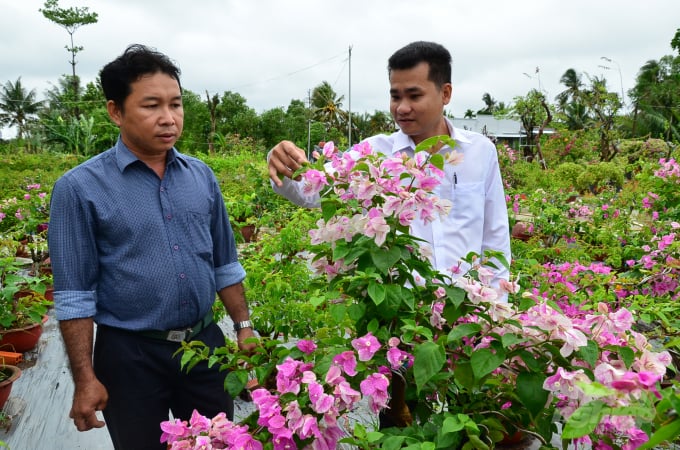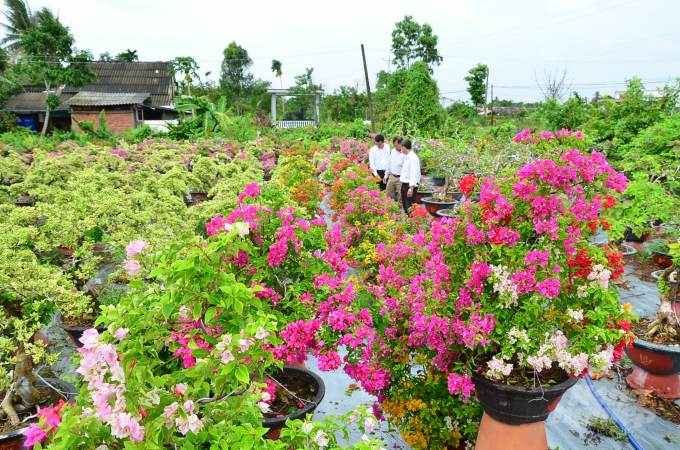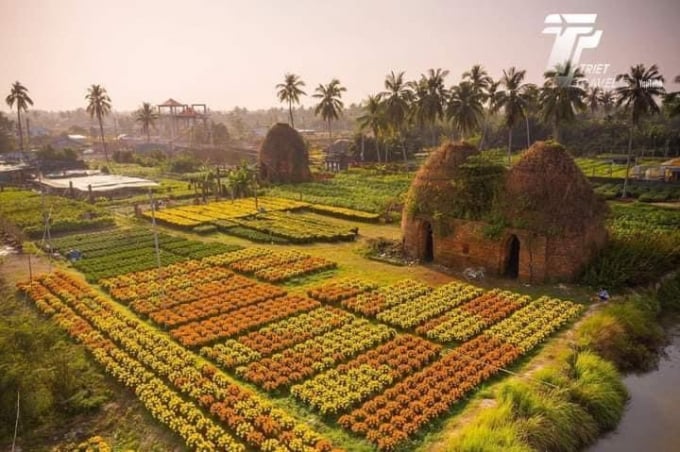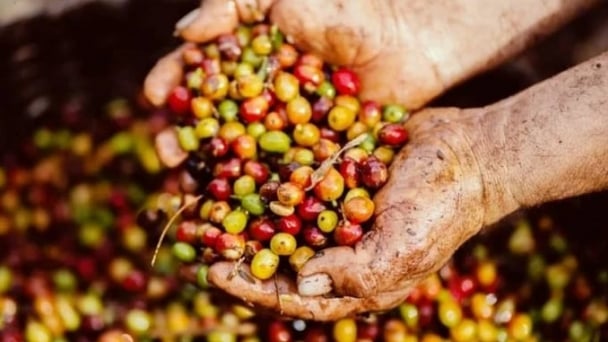June 17, 2025 | 14:23 GMT +7
June 17, 2025 | 14:23 GMT +7
Hotline: 0913.378.918
June 17, 2025 | 14:23 GMT +7
Hotline: 0913.378.918
Tran Thanh Phuong, a paperflower gardener in Lan Dong hamlet, Phu Son commune, Cho Lach district, Ben Tre province) recalled that terrible event. "Usually during Tet I sold 500-1,000 paperflower roots, gaining a turnover of VND 300 - 400 million. During the Tet holiday of that year, I rented a whole lot at the Convention Center of Dong Nai province to present the flowers. I couldn’t sell any of them, so I had no choice but to bring them back. Many people in the hamlet also fell into the same situation. No one had the mind to enjoy Tet anymore. They didn’t want to drink because the wine had become bitter in the mouth, unswallowable.”
“We build houses right in the garden. We repair the plants and change the pots ourselves. We even have to bring them to the veranda or into the house to avoid the rain. If there is poison in the flower preparations, we will be the first to suffer. And our grandparents used to plant paperflower for entertainment all this time. If the flower were possessed by evil spirits, who would dare to continue?"

Tran Thanh Phuong (left) and officials of Phu Son commune visiting the paperflower garden. Photo: Duong Dinh Tuong.
Later, Vu Gia Hien (Director of the Culture and Tourism Application Research Center, and advisor of the Ben Tre Startup Innovation Group) tried his best to save paperflower planting on this land.
“When paperflower planting was on the rise, suddenly there was a certain group on social networks saying paperflower was a flower worshiping the devil, making it impossible for the people to sell flowers for 1 - 2 years. Buyers became afraid, and noone would dare to buy this type of flower. It happened when paperflower was already the main flower of many communes in Cho Lach district.
“After hearing that, I pity the people so much. I wanted to save them. I thought I had to "play" in a very folk way. First, I wrote a poem, describing the value of paperflower in the direction of being a sacred flower that Shennong created - a non-causal flower. Based on the theory of Buddhism, it was the flower of heaven, of Buddha, already transcended.
“I sent the poem to the district and then let people spread it on social networks. I still felt uncertain, so I wrote an article on the internet describing the reason paperflower existed, that Shennong created a non-causal flower, able to ward off evil spirits, so its feng shui value is undoubted. Paperflower itself has no legend, nothing to confirm it, so I had to create those "legends".
On the occasion of the first seminar on paperflower organized by the provincial People's Committee, I brought 18 scientists there to explain to the people. After there were poems, literature, "legends", and even a scientific conference on paperflower, those who spouted nonsense about paperflower attracting evil spirits ran with their tails between their legs.”
Phu Son Commune People's Committee at that time also invited a representative of Can Tho University to explain and confirm that there were no cancer-causing agents in their flower preparations, so the situation was temporarily calmed down.

Phi's garden is full of vibrant colors with many types of paperflower. Photo: Duong Dinh Tuong.
Phuong is a member of the papperflower cooperative group with 44 members. Including this Lan Dong hamlet, it is easy to say that there are more than 100 households making paperflowers.
Each garden house has an average area of 500 - 6,000 m2, making from 1,000 - 5,000 roots/year. In terms of scale compared to Sa Dec flower village of Dong Thap province, it is far behind, but this place can help people earn a very high income. Many households can reach VND 700-800 million to VND 1 billion per year. Farmers here do not sell the flowers raw. They sell using their intelligence. All of the flower roots are trimmed artistically and grafted with branches of different colors.
Phu Son commune currently has 5 seedling and ornamental flower craft villages with over 1,000 households, and 7 cooperative production groups attracting about 500 households to participate. The income level of the members is quite stable, estimated at more than VND 100 million/person/year.
Under the giant white paperflower tree, the shadow of Phan The Dung, commonly known as Sau Dung, kept moving back and forth. The scissors in his hand quickly pruned leaves and cut branches. Being 64 years olds this year, the man is loved by the neighbors thanks to his high skills. At the end of every year the flowers in his garden are more abundant and vibrantly colorful than many other gardens.

Sau Dung pruning white paperflower in the garden. Photo: Duong Dinh Tuong.
Sau Dung said, “If you specialize in paperflower planting, you have to research and study how to take care of the flowers. Like me working for decades from childhood until now, I still have to learn from experience all the time because every year the weather creates a new situation for the tree. Paperflower blooms a lot under the sun, and my job becomes very easy, but how to handle the situation when the rain comes requires further studies, not to mention the soil used for long-term stores a lot of pathogens.
I always have 5,000 - 6,000 flower plants in my garden. I buy embryos in Sa Dec for VND 5,000 - 6,000/bag. After a few months of caring I will perform color grafting. At the end of the year I can sell a pot for VND 100,000.
Usually I hire 1-2 people for assistance, but when it's busy, I have to hire up to 10 people. If we do the math, each year the profit can be up to a few hundred million VND! I'm weakened now due to high age, so I only make small trees that are easy to do and easy to sell. But for young people like my nephew Phi, he has become the boss now since he has the capital. My boy invests in buying all the big roots to create a canopy and then performs multi-color grafting. Its garden has many people flocking to see and admire, including the big shots.”

Phu Son flower village on Tet holiday. Photo provided by the Commune People's Committee.
In the endless flow of stories about the village and the paperflower career, I heard Vice Chairman of Phu Son commune Dang Quoc Viet announce a very good news. The commune has just been qualified for “Advanced new countryside”. The paperflower industry has made a great contribution to this achievement when it brings approximately VND 100 billion per year and creates a per capita income of VND 61 million/year for Phu Son.
Translated by Samuel Pham
![Turning wind and rain into action: [5] Hue applies modern technology in disaster forecasting](https://t.ex-cdn.com/nongnghiepmoitruong.vn/608w/files/news/2025/06/17/z6704423696987_15fd32ffc26d590d204d520c9dac6786-nongnghiep-093938.jpg)
(VAN) In Hue city, modern technology has recently been applied in meteorological and hydrological forecasting and warning, helping to reduce the damage caused by natural disasters.

(VAN) A cutting-edge farming technique being implemented on an experimental ranch in Arizona's Sonoran Desert has already saved a billion gallons of water over five years, according to Civil Eats.

(VAN) Poultry and pig production and the environment can be boosted through enhanced water technology, according to new research.

(VAN) Coffee prices on June 16, 2025 are unchanged. In Vietnam, local trading prices are holding steady, ranging around VND 112,000 – VND 112,500/kg.
![Turning wind and rain into action: [4] Bringing climate bulletins to remote and isolated areas](https://t.ex-cdn.com/nongnghiepmoitruong.vn/608w/files/linhnhp/2025/06/14/1152-z6704423696987_15fd32ffc26d590d204d520c9dac6786-nongnghiep-151141.jpg)
(VAN) The Vietnam Agriculture and Nature Newspaper interviewed Mr. Vu Thai Truong, Acting Head of Climate Change and Environment at UNDP Vietnam, to gain deeper insight into how climate bulletins are delivered to farmers.

(VAN) In Tien Giang, a high-tech shrimp farm has developed a distinctive energy-saving farming model that has yielded promising results.
![Turning wind and rain into action: [3] 300.000 farmers benefit from agro-climatic bulletins](https://t.ex-cdn.com/nongnghiepmoitruong.vn/608w/files/news/2025/06/12/e5a48259d6a262fc3bb3-nongnghiep-125122.jpg)
(VAN) The agro-climatic bulletin has become a valuable tool for farmers in the Mekong Delta. After more than five years of implementation, the initiative is gradually being expanded nationwide.